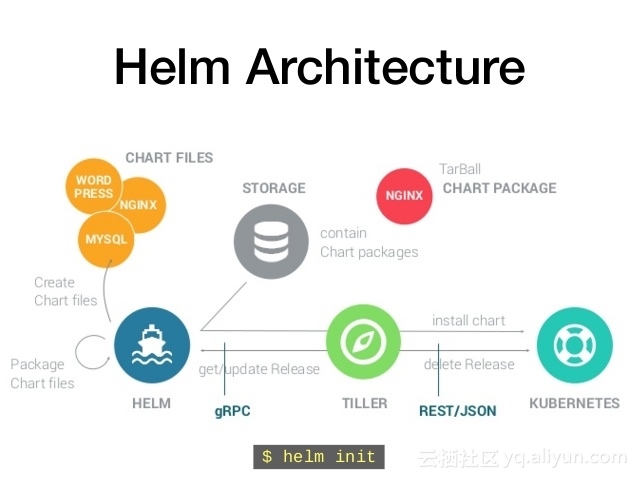整体架构
1.为什么要用?
首先在原来项目中都是基于yaml文件来进行部署发布的,而目前项目大部分微服务化或者模块化,会分成很多个组件来部署,每个组件可能对应一个deployment.yaml,一个service.yaml,一个Ingress.yaml还可能存在各种依赖关系,这样一个项目如果有5个组件,很可能就有15个不同的yaml文件,这些yaml分散存放,如果某天进行项目恢复的话,很难知道部署顺序,依赖关系等,而所有这些包括
- 基于yaml配置的集中存放
- 基于项目的打包
- 组件间的依赖
都可以通过helm来进行解决。
2.Helm 基本概念
Helm 可以理解为 Kubernetes 的包管理工具,可以方便地发现、共享和使用为Kubernetes构建的应用,它包含几个基本概念
- Chart:一个 Helm 包,其中包含了运行一个应用所需要的镜像、依赖和资源定义等,还可能包含 Kubernetes 集群中的服务定义
- Release: 在 Kubernetes 集群上运行的 Chart 的一个实例。在同一个集群上,一个 Chart 可以安装很多次。每次安装都会创建一个新的 release。例如一个 MySQL Chart,如果想在服务器上运行两个数据库,就可以把这个 Chart 安装两次。每次安装都会生成自己的 Release,会有自己的 Release 名称。
- Repository:用于发布和存储 Chart 的仓库。
3.Helm 组件及架构
Helm 采用客户端/服务器架构,有如下组件组成:
- Helm CLI 是 Helm 客户端,可以在本地执行
- Tiller 是服务器端组件,在 Kubernetes 群集上运行,并管理 Kubernetes 应用程序的生命周期
- Repository 是 Chart 仓库,Helm客户端通过HTTP协议来访问仓库中Chart的索引文件和压缩包。

4.Helm的安装
在下列网站下载helm的相关版本
https://github.com/kubernetes/helm/releases
tar -xvzf $HELM.tar.gz
mv linux-amd64/helm /usr/local/bin/helm
在K8s节点上配置.kube/config(我是因为之前没搞这些,大家如果搞过就直接忽略)
[root@k8s-node-1 ~]# kubectl config set-cluster kubernetes --server=http://192.168.0.104:8080 Cluster "kubernetes" set. [root@k8s-node-1 ~]# kubectl config set-credentials admin User "admin" set. [root@k8s-node-1 ~]# kubectl config set-context kubernetes > --cluster=kubernetes > --user=admin Context "kubernetes" set. [root@k8s-node-1 ~]# kubectl config use-context kubernetes Switched to context "kubernetes".
- 运行安装
先创建用户和角色。
apiVersion: v1 kind: ServiceAccount metadata: name: tiller namespace: kube-system --- apiVersion: rbac.authorization.k8s.io/v1beta1 kind: ClusterRoleBinding metadata: name: tiller roleRef: apiGroup: rbac.authorization.k8s.io kind: ClusterRole name: cluster-admin subjects: - kind: ServiceAccount name: tiller namespace: kube-system
[root@k8s-node-1 ~]# helm init --service-account tiller --skip-refresh $HELM_HOME has been configured at /root/.helm. Tiller (the Helm server-side component) has been installed into your Kubernetes Cluster. Happy Helming!
然后去查看
[root@k8s-node-1 ~]# kubectl get pod -n kube-system -l app=helm NAME READY STATUS RESTARTS AGE tiller-deploy-3018021184-dxpfj 0/1 ContainerCreating 0 26s
[root@k8s-node-1 ~]# kubectl describe pods tiller-deploy-3018021184-dxpfj -n kube-system Name: tiller-deploy-3018021184-dxpfj Namespace: kube-system Node: k8s-node-1/192.168.0.105 Start Time: Fri, 23 Feb 2018 18:41:28 +0800 Labels: app=helm name=tiller pod-template-hash=3018021184 Status: Pending IP: Controllers: ReplicaSet/tiller-deploy-3018021184 Containers: tiller: Container ID: Image: gcr.io/kubernetes-helm/tiller:v2.8.1 Image ID: Ports: 44134/TCP, 44135/TCP State: Waiting Reason: ContainerCreating Ready: False Restart Count: 0 Liveness: http-get http://:44135/liveness delay=1s timeout=1s period=10s #success=1 #failure=3 Readiness: http-get http://:44135/readiness delay=1s timeout=1s period=10s #success=1 #failure=3 Volume Mounts: /var/run/secrets/kubernetes.io/serviceaccount from tiller-token-xng0h (ro) Environment Variables: TILLER_NAMESPACE: kube-system TILLER_HISTORY_MAX: 0 Conditions: Type Status Initialized True Ready False PodScheduled True Volumes: tiller-token-xng0h: Type: Secret (a volume populated by a Secret) SecretName: tiller-token-xng0h QoS Class: BestEffort Tolerations: <none> Events: FirstSeen LastSeen Count From SubObjectPath Type Reason Message --------- -------- ----- ---- ------------- -------- ------ ------- 1m 1m 1 {default-scheduler } Normal Scheduled Successfully assigned tiller-deploy-3018021184-dxpfj to k8s-node-1 1m 1m 1 {kubelet k8s-node-1} spec.containers{tiller} Normal Pulling pulling image "gcr.io/kubernetes-helm/tiller:v2.8.1"
发现需要gcr.io/kubernetes-helm/tiller:v2.8.1
一番折腾后运行后完成,因为找不到2.8.1版本,所以最后搞了个2.6.0版本
[root@k8s-master helm]# helm init --service-account tiller --upgrade -i index.tenxcloud.com/kubernetes-helm/tiller:v2.6.0 --skip-refresh Creating /root/.helm Creating /root/.helm/repository Creating /root/.helm/repository/cache Creating /root/.helm/repository/local Creating /root/.helm/plugins Creating /root/.helm/starters Creating /root/.helm/cache/archive Creating /root/.helm/repository/repositories.yaml Adding stable repo with URL: https://kubernetes-charts.storage.googleapis.com Adding local repo with URL: http://127.0.0.1:8879/charts $HELM_HOME has been configured at /root/.helm. Tiller (the Helm server-side component) has been installed into your Kubernetes Cluster. Happy Helming!
- 问题解决
先解决两个错误:
- unable to do port forwarding: socat not found.
[root@k8s-master hello-svc]# helm version Client: &version.Version{SemVer:"v2.8.1", GitCommit:"6af75a8fd72e2aa18a2b278cfe5c7a1c5feca7f2", GitTreeState:"clean"} E0224 14:13:16.077226 7416 portforward.go:331] an error occurred forwarding 37271 -> 44134: error forwarding port 44134 to pod 76a7312e49220a229e443546a4b32d3e0406f09fd9b3646b3d30f6833e121375, uid : unable to do port forwarding: socat not found. Error: cannot connect to Tiller
解决办法在node节点安装socat
yum install socat
- 版本不一致
重新下载一致的版本包,和images的版本保持一致
5.项目中如何使用
-
针对每个项目形成一个chart,最后形成一个Chart Package
比如下面针对hello-svc这个基于tomcat的项目,先生成一个chart的结构
- 创建chart及部署
[root@k8s-master ~]# helm create hello-svc
Creating hello-svc
按照我们自己的需求修改模板中的deployment.yaml,service.yaml和values.yaml文件
[root@k8s-master templates]# cat deployment.yaml apiVersion: extensions/v1beta1 kind: Deployment metadata: name: tomcatjmx spec: replicas: {{.Values.replicas}} template: metadata: labels: tomcat-app: "tomcatjmx" version: "1" spec: containers: - name: tomcatjmx image: tomcat:{{.Values.images.dockerTag}} ports: - containerPort: {{.Values.images.Port}} name: tomcatport - containerPort: 35135 name: jmx
[root@k8s-master templates]# cat service.yaml apiVersion: v1 kind: Service metadata: name: {{.Values.service.name}} labels: tomcat-app: tomcatjmx spec: ports: - port: {{.Values.service.Port}} protocol: TCP targetPort: 8080 name: http - name: jmx protocol: TCP port: 35135 targetPort: {{.Values.service.targetPort}} type: NodePort selector: tomcat-app: tomcatjmx
[root@k8s-master hello-svc]# cat values.yaml # Default values for hello-svc. # This is a YAML-formatted file. # Declare variables to be passed into your templates. replicas: 1 images: dockerTag: jmxv4 Port: 8080 service: name: tomcatjmxsvc Port: 80 targetPort: 35135
相应的NOTES.txt也进行调整直到验证没有问题,验证完成通过install安装
helm install --dry-run --debug ./
[root@k8s-master hello-svc]# helm install ./ NAME: kindly-worm LAST DEPLOYED: Sat Feb 24 14:45:58 2018 NAMESPACE: default STATUS: DEPLOYED RESOURCES: ==> v1/Service NAME CLUSTER-IP EXTERNAL-IP PORT(S) AGE tomcatjmxsvc 10.254.25.181 <nodes> 80:32733/TCP,35135:30714/TCP 1s ==> v1beta1/Deployment NAME DESIRED CURRENT UP-TO-DATE AVAILABLE AGE tomcatjmx 1 1 1 0 1s NOTES: 1. Get the application URL by running these commands: export POD_NAME=$(kubectl get pods -l "app=hello-svc,release=kindly-worm" -o jsonpath="{.items[0].metadata.name}") echo "Visit http://127.0.0.1:8080 to use your application" kubectl port-forward $POD_NAME 8080:80 [root@k8s-master hello-svc]# helm list NAME REVISION UPDATED STATUS CHART NAMESPACE kindly-worm 1 Sat Feb 24 14:45:58 2018 DEPLOYED hello-svc-0.1.0 default
- 形成一个chart Package
打包形成一个tgz文件,估计是每个项目一个chart,对应一个tgz
helm package ./
-
Chart Package的集中管理和存放
上面我们是从本地的目录结构中的chart去进行部署,如果要集中管理chart,就需要涉及到repository的问题,因为helm repository都是指到外面的地址,接下来我们可以通过minio建立一个企业私有的存放仓库。
Minio提供对象存储服务。它的应用场景被设定在了非结构化的数据的存储之上了。众所周知,非结构化对象诸如图像/音频/视频/log文件/系统备份/镜像文件…等等保存起来管理总是不那么方便,size变化很大,类型很多,再有云端的结合会使得情况更加复杂,minio就是解决此种场景的一个解决方案。Minio号称其能很好的适应非结构化的数据,支持AWS的S3,非结构化的文件从数KB到5TB都能很好的支持。
Minio的使用比较简单,只有两个文件,服务端minio,客户访问端mc,比较简单。
在项目中,我们可以直接找一台虚拟机作为Minio Server,提供服务,当然minio也支持作为Pod部署。
1.安装配置Minio
下载
在https://dl.minio.io/client/mc/release/linux-amd64/ 下载客户端程序mc和服务端程序minio
启动minio服务
minio server ./repository
针对使用得客户端加入security和token信息
./mc config host add myminio http://192.168.44.108:9000 B0SW3MZ00J7OCG2JCG5D nZrG2olrz+aDbhbzVhft6JivkkoPQe2gp5JaG+XO
创建一个bucket同时设置权限
mc mb myminio/minio-helm-repo
mc policy download myminio/minio-helm-repo
安装完成后通过浏览器访问minio的界面,http://192.168.44.108:9000/
2.将我们上面创建的chart Package传入Minio的Repository
index.yaml为了让helm对里面的包进行索引,找到各种entry,每个entry是一个项目,每个项目对应一个chart Package.
在本地建立一个index.yaml,然后上传,将来在使用的时候可以通过程序实现自动添加。
[root@k8s-master minio-helm-repo]# cat index.yaml apiVersion: v1 entries: hello-svc: - apiVersion: v1 description: Distributed object storage server built for cloud applications and devops. digest: 8440f6f064ed91a75194e77d4b2be99c491c1cb04fb34bca4a36a5be67e1ef2c name: hello-svc urls: - http://192.168.44.108:9000/minio-helm-repo/hello-svc-0.1.0.tgz version: 0.1.0
将之前的tgz package和index文件都传入。
./mc cp ./index.yaml myminio/minio-helm-repo ./index.yaml: 601 B / 601 B ┃▓▓▓▓▓▓▓▓▓▓▓▓▓▓▓▓▓▓▓▓▓▓▓▓▓▓▓▓▓▓▓▓▓▓▓▓▓▓▓▓▓▓▓▓▓▓▓▓▓▓▓┃ 100.00% 47.73 KB/s 0s
./mc cp /root/hello-svc/hello-svc-0.1.0.tgz myminio/minio-helm-repo ...-svc-0.1.0.tgz: 1.50 KB / 1.50 KB ┃▓▓▓▓▓▓▓▓▓▓▓▓▓▓▓▓▓▓▓▓▓▓▓▓▓▓▓▓▓▓▓▓▓▓▓▓▓▓▓▓▓▓▓▓▓▓▓┃ 100.00% 48.00 KB/s 0s
3.设置Helm
在helm中加入repository,加入完成后可以通过helm repo list进行罗列。修改了index.yaml后也需要用helm repo update进行更新。
[root@k8s-master helm]# helm repo add myrepo http://192.168.44.108:9000/minio-helm-repo "myrepo" has been added to your repositories
[root@k8s-master helm]# helm repo update Hang tight while we grab the latest from your chart repositories... ...Skip local chart repository ...Unable to get an update from the "stable" chart repository (https://kubernetes-charts.storage.googleapis.com): Get https://kubernetes-charts.storage.googleapis.com/index.yaml: dial tcp: lookup kubernetes-charts.storage.googleapis.com on [::1]:53: read udp [::1]:59458->[::1]:53: read: connection refused ...Successfully got an update from the "myrepo" chart repository Update Complete. ⎈ Happy Helming!⎈
-
基于Minio的Repository进行Helm的部署
好了,一切就绪,先search一下
[root@k8s-master helm]# helm search hello WARNING: Repo "stable" is corrupt or missing. Try 'helm repo update'.NAME VERSION DESCRIPTION local/hello-svc 0.1.0 A Helm chart for Kubernetes myrepo/hello-svc 0.1.0 Distributed object storage server built for clo...
[root@k8s-master helm]# helm install myrepo/hello-svc NAME: quelling-hound LAST DEPLOYED: Sat Feb 24 17:14:23 2018 NAMESPACE: default STATUS: DEPLOYED RESOURCES: ==> v1/Service NAME CLUSTER-IP EXTERNAL-IP PORT(S) AGE tomcatjmxsvc 10.254.180.188 <nodes> 80:31790/TCP,35135:31132/TCP 2s ==> v1beta1/Deployment NAME DESIRED CURRENT UP-TO-DATE AVAILABLE AGE tomcatjmx 1 1 1 0 2s NOTES: 1. Get the application URL by running these commands: export POD_NAME=$(kubectl get pods -l "app=hello-svc,release=quelling-hound" -o jsonpath="{.items[0].metadata.name}") echo "Visit http://127.0.0.1:8080 to use your application" kubectl port-forward $POD_NAME 8080:80
这里search能搜索到但是部署不上去的问题折腾了一下,最后原因是那个Index.yaml文件写得有问题。再度更新后成功部署。

